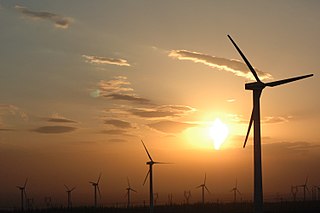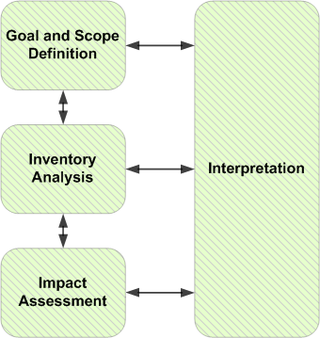
Wind power is the use of wind energy to generate useful work. Historically, wind power was used by sails, windmills and windpumps, but today it is mostly used to generate electricity. This article deals only with wind power for electricity generation. Today, wind power is generated almost completely with wind turbines, generally grouped into wind farms and connected to the electrical grid.

Life cycle assessment or LCA is a methodology for assessing environmental impacts associated with all the stages of the life cycle of a commercial product, process, or service. For instance, in the case of a manufactured product, environmental impacts are assessed from raw material extraction and processing (cradle), through the product's manufacture, distribution and use, to the recycling or final disposal of the materials composing it (grave).

A wind farm or wind park, also called a wind power station or wind power plant, is a group of wind turbines in the same location used to produce electricity. Wind farms vary in size from a small number of turbines to several hundred wind turbines covering an extensive area. Wind farms can be either onshore or offshore.
The wind profile power law is a relationship between the wind speeds at one height, and those at another.
Airborne wind energy (AWE) is the direct use or generation of wind energy by the use of aerodynamic or aerostatic lift devices. AWE technology is able to harvest high altitude winds, in contrast to wind turbines, which use a rotor mounted on a tower.
Energy planning has a number of different meanings, but the most common meaning of the term is the process of developing long-range policies to help guide the future of a local, national, regional or even the global energy system. Energy planning is often conducted within governmental organizations but may also be carried out by large energy companies such as electric utilities or oil and gas producers. These oil and gas producers release greenhouse gas emissions. Energy planning may be carried out with input from different stakeholders drawn from government agencies, local utilities, academia and other interest groups.
Specialized wind energy software applications aid in the development and operation of wind farms.
WAsP is a Windows program for predicting wind climates, wind resources, and energy yields from wind turbines and wind farms. An application of the software is determining good locations to develop wind farms.
The wind power industry is involved with the design, manufacture, construction, and maintenance of wind turbines. The modern wind power industry began in 1979 with the serial production of wind turbines by Danish manufacturers. The industry is undergoing a period of rapid globalization and consolidation.
This page is an index of sustainability articles.
Wind resource assessment is the process by which wind power developers estimate the future energy production of a wind farm. Accurate wind resource assessments are crucial to the successful development of wind farms.
New York has 2,192 MW of installed wind power capacity as of 2022. Most of New York's wind power is located in upstate New York as onshore wind farms. New York has set a goal of developing 9,000 MW of offshore installed wind power capacity by 2035 that will power an estimated 6 million homes. As of October 2022, New York has five offshore wind farms in development with approximately 4,300 MW installed capacity.
GoldSim is dynamic, probabilistic simulation software developed by GoldSim Technology Group. This general-purpose simulator is a hybrid of several simulation approaches, combining an extension of system dynamics with some aspects of discrete event simulation, and embedding the dynamic simulation engine within a Monte Carlo simulation framework.
The following outline is provided as an overview of and topical guide to wind energy:
Despite its high potential for wind energy generation, wind power in Kenya currently contributes only about 16 percent of the country's total electrical power. However, its share in energy production is increasing. Kenya Vision 2030 aims to generate 2,036 MW of wind power by 2030. To accomplish this goal, Kenya is developing numerous wind power generation centers and continues to rely on the nation's three major wind farms: the Lake Turkana Wind Power Station, the Kipeto Wind Power Station, and the Ngong Hills Wind Farm. While these wind power stations are beneficial to help offset fossil fuel usage and increase overall energy supply reliability in Kenya, project developments have also negatively impacted some indigenous communities and the parts of the environment surrounding the wind farms.

Wind power in Thailand amounted to an installed production capacity of 224.5 MW as of the end of 2014. Installed capacity was 112 MW at the end of 2012, with 111 MW added in 2013, and a minor amount added in 2014. This ranked Thailand 46th in the world by installed capacity as of 2015.
Meteodyn WT, commonly known as Meteodyn is a wind energy software program that uses computational fluid dynamics (CFD) to conduct wind resource assessment. Developed and marketed by Meteodyn, Meteodyn WT was first released in September 2009. The software quantifies the wind resource in a desired terrain in order to assess the feasibility of a proposed wind farm. The software's objective is to design the most profitable wind farm. This is achieved by taking into account the measured wind data at a measurement tower and the terrain conditions. Both of these are essential to be able to obtain the wind conditions and therefore the wind resources of the desired terrain.

The Global Wind Atlas is a web-based application developed to help policymakers and investors identify potential high-wind areas for wind power generation virtually anywhere in the world, and perform preliminary calculations. It provides free access to data on wind power density and wind speed at multiple heights using the latest historical weather data and modeling, at an output resolution of 250 meters. It is owned and maintained by the Wind Energy Department of the Technical University of Denmark and in recent years has been developed in close partnership with the World Bank, with funding provided by the Energy Sector Management Assistance Program (ESMAP).
WindStation is a wind energy software which uses computational fluid dynamics (CFD) to conduct wind resource assessments in complex terrain. The physical background and its numerical implementation are described in. and the official manual of the software.

The Global Solar Atlas (GSA) is a free, online, map-based application that provides information on solar resource and photovoltaic power potential globally. It features the online interactive map tools, simplified photovoltaic (PV) power calculator, reporting tools and the extensive download section. It is intended to provide policy makers, academia, and renewable energy stakeholders to raise awareness in the solar energy domain, support the development of policies and plans, and for initial zoning and site identification purposes.





